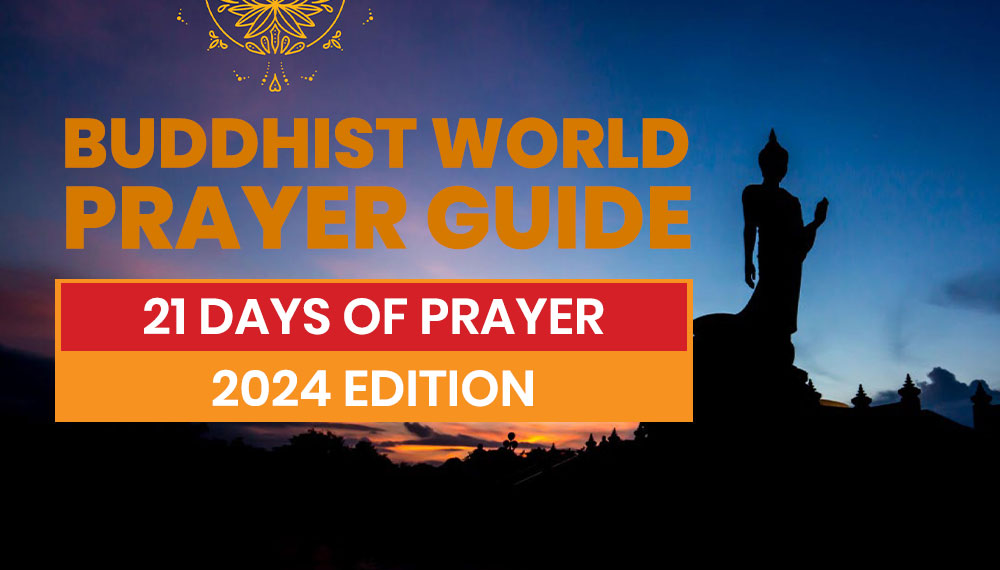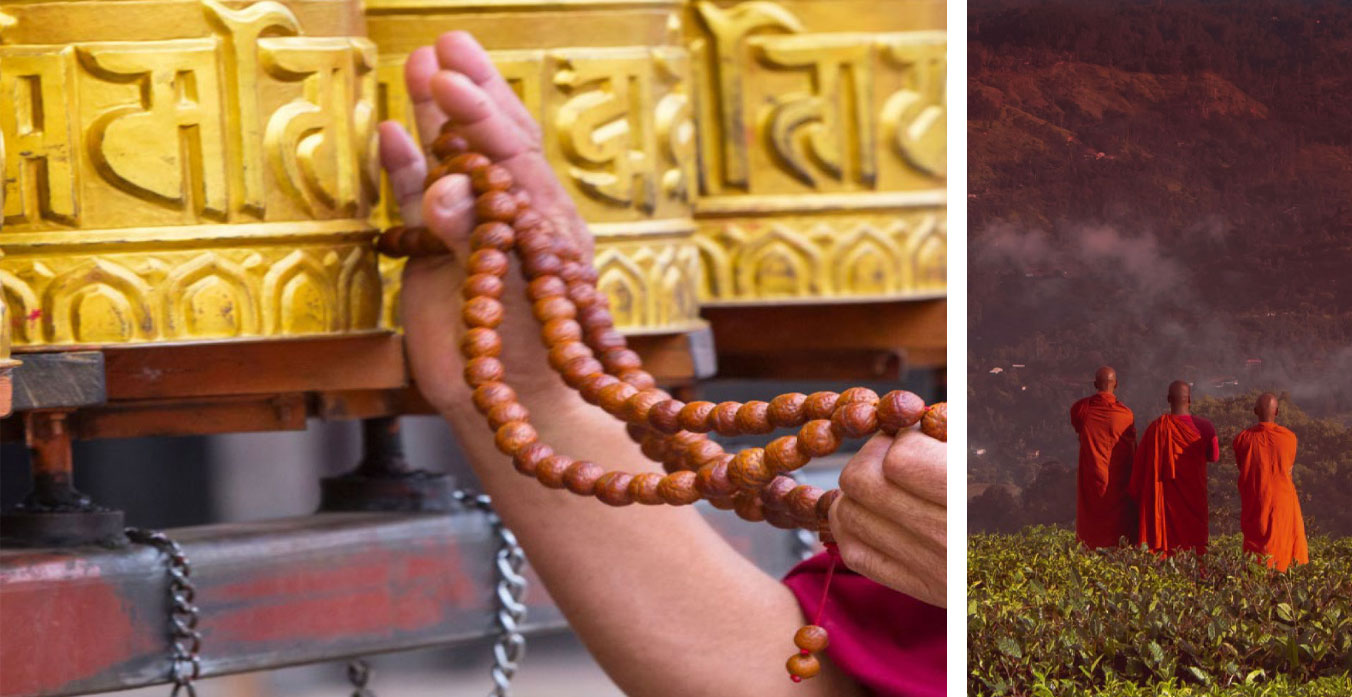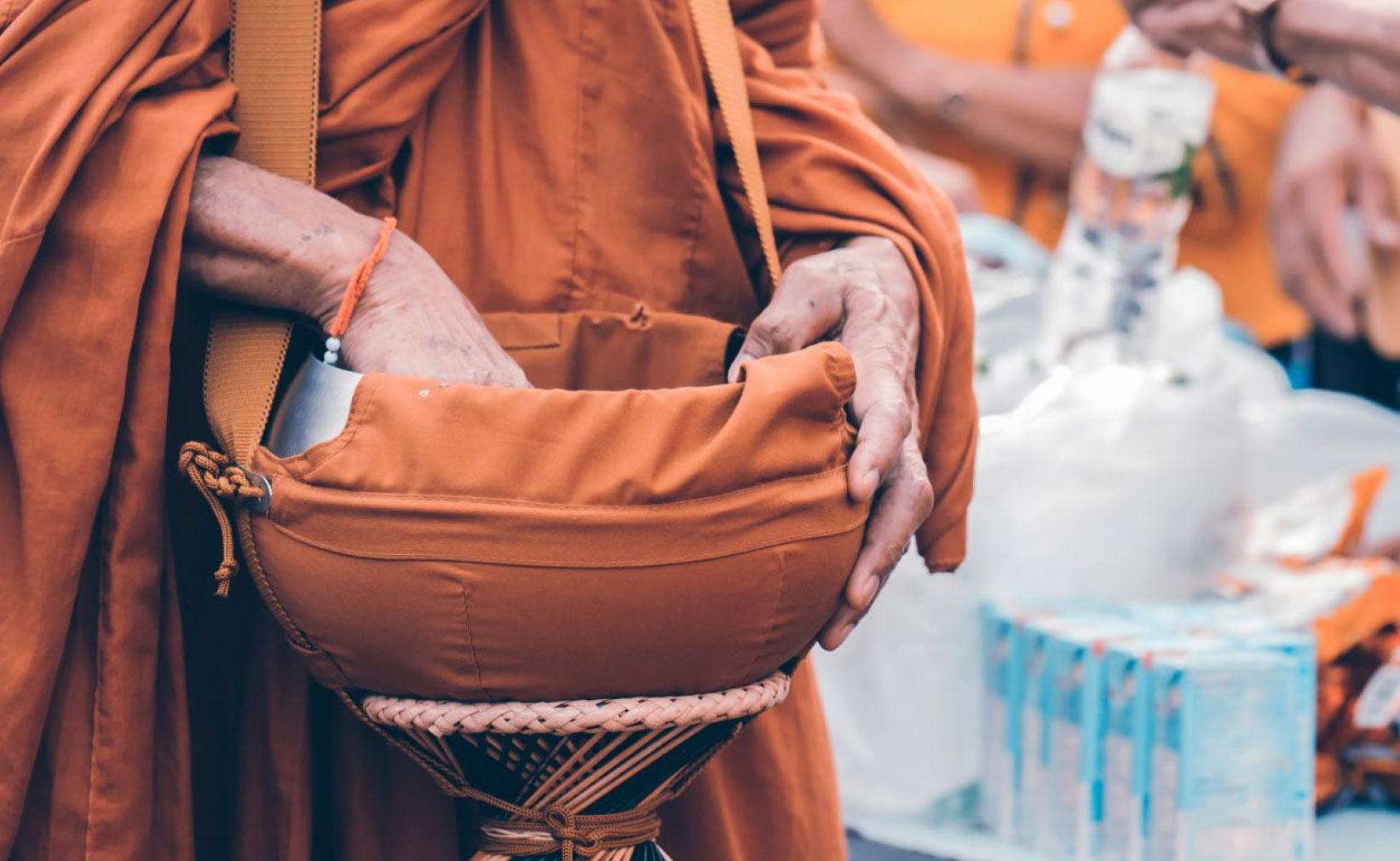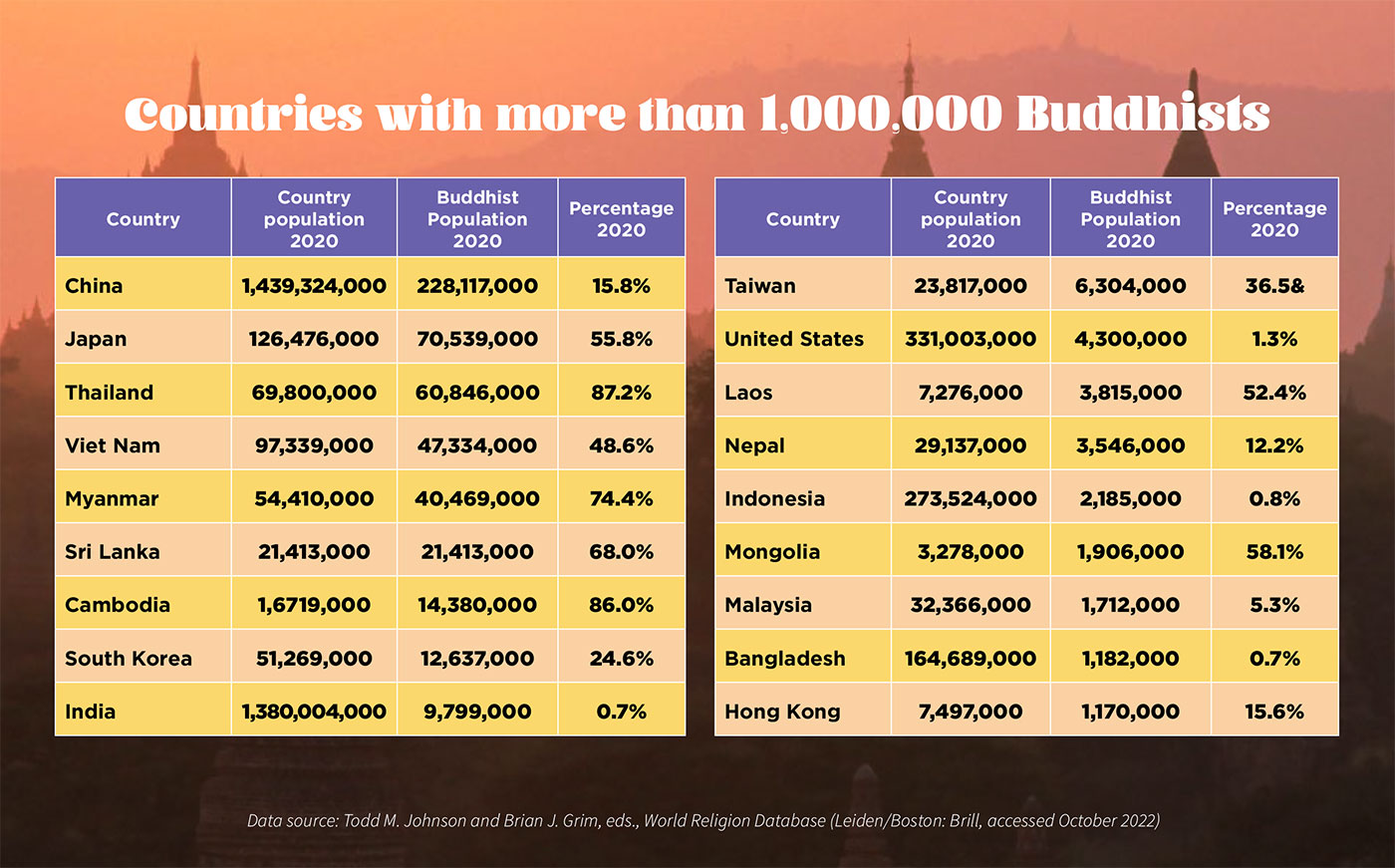
”Älä pala. pidä itsesi täynnä ja liekkejä. Olkaa valppaita herran palvelijoita, iloisesti odottavia. Älä luovuta vaikeina aikoina; rukoile sitä kovemmin." Roomalaisille 12:11-12 MSG versio
Tämä ensimmäisen vuosisadan varoitus apostoli Paavalilta olisi voitu yhtä helposti kirjoittaa tänään. Pandemian aiheuttaman kaaoksen, Ukrainan sodan, Lähi-idän uuden sodan, Jeesuksen seuraajien vainon suuressa osassa maailmaa ja taloudellisen taantuman vuoksi on helppo nostaa kätemme ja kysyä: "Mitä voi henkilö tekee?"
Paavali antaa meille vastauksen. Pysy keskittyneenä Jumalan sanaan odottaen, että Hän vastaa, ja "rukoile sitä kovemmin".
Tämän oppaan avulla kehotamme sinua rukoilemaan erityisesti, että Jumala tulisi tunnetuksi miljardille ihmiselle eri puolilla maailmaa, jotka ovat ainakin nimellisesti buddhalaisia. Joka päivä 21. tammikuuta 2024 alkaen opit jotain buddhalaisesta käytännöstä ja vaikutuksesta eri paikassa.
Tämä rukousopas käännetään 30 kielelle ja jaetaan yli 5000 rukousverkoston kautta maailmanlaajuisesti. Osallistut yli 100 miljoonan Jeesuksen seuraajan kanssa esirukoukseen buddhalaisten naapureidemme puolesta.
Monet päivittäisistä profiileista keskittyvät tiettyyn kaupunkiin. Tämä on tahallista. Kuvatut kaupungit ovat samoja kaupunkeja, joissa maanalaisen kirkon rukousryhmät palvelevat juuri sinä päivinä, jolloin rukoilet! Esirukouksesi heidän työssään etulinjassa on erittäin tärkeää.
Toivotamme sinut tervetulleeksi liittymään joukkoomme, pysymään "iloisena odottavana" ja "rukoilemaan sitä kovemmin".
Jeesus on Herra!

Prinssi Gautama syntyi nykypäivän Nepalin eteläosassa kuudennella vuosisadalla eKr. Paikallinen shamaani huomasi jälkiä lapsen ruumiissa ja ennusti, että hänestä kasvaisi maailman hallitsija ja valistunut. Hänen isänsä halusi Gautamasta suuren hallitsijan suojella häntä tarjoamalla ylellistä elämää.
29-vuotiaana Gautama kuitenkin joutui kärsimyksiin asuinpalatsin ulkopuolella. Tämän seurauksena hän vietti kuusi vuotta vaeltavana askeettina etsiessään ratkaisua kärsimysongelmaan. Turhaan hän kokeili erilaisia meditaatiotekniikoita toivoen oivallusta. Lopulta hän päätti istua bodhi-puun alla, kunnes hän oli saavuttanut etsimäänsä valaistumisen. Vaikka Mara (Paha) houkutteli häntä, hän pysyi ja saavutti lopulta sen, mitä hän uskoi olevan korkeimman totuuden oivallus. Siitä lähtien häntä pidettiin "Buddhana", joka tarkoittaa "herännyt" tai "valaistunut".
Buddha löysi alkuperäiset kumppaninsa etsiessään valaistumista ja saarnasi heille ensimmäisen saarnansa. Toisin kuin useimmat uskonnot, niissä ei ollut ylintä jumaluutta. Sen sijaan hän hahmotteli "neljä jaloa totuutta":
Buddhan mukaan "kärsimys" johtuu siitä, että takertumme pysymättömiin asioihin ja kaipaamme niitä, mikä pitää meidät kaikki kiinni jatkuvassa kuoleman ja uudestisyntymisen prosessissa, jossa kaikki, jopa oma itse, on pysyvää ja illuusiota. Ainoa tapa päästä eroon tästä loputtomasta uudestisyntymien kierrosta on kulkea "Keskipolkua", välttäen äärimmäisyyksiä ja elämään oikean ymmärryksen, ajatuksen, puheen, käytöksen, toimeentulon, ponnistelujen, tietoisuuden ja lopulta oikean keskittymisen kanssa. Lopputavoite ei ole ikuinen yhteys Jumalan kanssa, vaan pikemminkin – kuten kynttilän liekin sammuminen – tila, jossa himo loppuu.
Ihmiset näkevät buddhalaisuuden omana kansanuskontonsa, vaikka se ei liity korkeaan jumalaan. Sellaisenaan se on kuin peitto, joka kaatuu olemassa olevien kulttuurien päälle ja mukautuu alla oleviin maisemiin. Tiibetissä shamanismin bon-uskonto peitettiin buddhalaisilla luostareilla meditaatiota varten. Buddhalaisessa Thaimaassa maallikot tarjoavat munkeille savukkeita almukulhoissaan; buddhalaisessa Bhutanissa tupakointi on kuitenkin synti. Thaimaan buddhalainen neuvosto kieltää tiukasti naisten vihkimisen ja kieltää naisia pääsemästä pyhille paikoille temppelialueen sisällä, mutta Nepal ja Englanti asettavat naismunkkeja. Kambodžan buddhalaiset eivät keskustele temppelissä ympäristöstä huolehtimisesta, kun taas länsibuddhalaiset sisällyttävät ympäristöaktivismin dharman harjoittamiseensa.
* Selvyyden vuoksi tämä opas noudattaa buddhalaisten termien sanskritin kirjoitusasua paalin kirjoitusasun sijaan. Dharma on sanskritin oikeinkirjoitus; paalin kirjoitusasu olisi dhamma.

Theravada-buddhalaisuus
syntyi Sri Lankasta, jossa Buddhan saarnat ja opetukset kanonisoitiin ensimmäisen kerran. Se keskittyy valaistumisen saavuttamiseen henkilökohtaisen meditaation ja hyvien tekojen kautta. Myanmar, Thaimaa, Kambodža ja Laos noudattavat tätä perinnettä.
Mahayana buddhalaisuus
syntyi Buddhalle luettujen tekstien perusteella, jotka opettivat, että bodhisattva tai valaistunut olento saattoi halutessaan viivyttää pääsyä nirvanaan (vapauden perimmäinen henkinen tavoite) vapauttaakseen muut tuntevat olennot karmisesta kärsimyksestä (perustuen henkilön menneisiin toimiin). Tätä buddhalaisuuden virtaa harjoitettiin perinteisesti Kiinassa, Japanissa, Vietnamissa ja Korean niemimaalla.
Tiibetin buddhalaisuus
syntyi Intiassa kuudennella jKr., keskittyen valaistumisen nopeuttamiseen rituaalikäytäntöjen avulla ja taivaallisten bodhisattvojen visualisoinnissa.
Viime vuosina länsimaalaiset ovat omaksuneet erilaisia buddhalaisuuden muotoja, jotka keskittyvät ensisijaisesti sisäisen rauhan etsimiseen. Jotkut ovat liittyneet Theravadan luostareihin etsiessään hengellistä puhdistumista meditaation avulla ja noudattamalla viittä perussääntöä. Toiset ovat sitoutuneet tiibetiläiseen lamaan (munkkiin), tutkimaan tiibetiläisiä tekstejä ja oppimaan laulamista. Toiset taas noudattavat länsimaista muotoa, jossa aasialaiset perinteet sekoittuvat länsimaisiin buddhalaisuuskäsityksiin. He jatkavat usein aiemmissa ammateissaan ja käyttävät jokapäiväisiä vaatteita, mutta viettävät aikaa meditaatiossa ja osallistuvat retriiteihin.
Viime vuosina länsimaalaiset ovat omaksuneet erilaisia buddhalaisuuden muotoja, jotka keskittyvät ensisijaisesti sisäisen rauhan etsimiseen. Jotkut ovat liittyneet Theravadan luostareihin etsiessään hengellistä puhdistumista meditaation avulla ja noudattamalla viittä perussääntöä. Toiset ovat sitoutuneet tiibetiläiseen lamaan (munkkiin), tutkimaan tiibetiläisiä tekstejä ja oppimaan laulamista. Toiset taas noudattavat länsimaista muotoa, jossa aasialaiset perinteet sekoittuvat länsimaisiin buddhalaisuuskäsityksiin. He jatkavat usein aiemmissa ammateissaan ja käyttävät jokapäiväisiä vaatteita, mutta viettävät aikaa meditaatiossa ja osallistuvat retriiteihin.


Ei käytössä


110 CITIES - IPC:n projekti a US 501(c)(3) No 85-3845307 | Lisätietoja | Sivuston tekijä: IPC MEDIA
110 CITIES - IPC:n projekti a US 501(c)(3) No 85-3845307 | Lisätietoja | Sivuston tekijä: IPC MEDIA